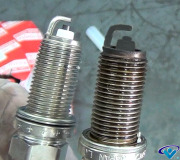Hi and thanks for using 2carpros.com
The first thing I would check is fuel pressure. If the regulator is allowing the pressure to get too high, then you will get a rich mixture. Also, the regulator is vacuum operated. Disconnect the vacuum hose from the regulator and make sure it isn't drawing fuel into the vacuum hose. If it is, replace the regulator.
Here is a link that shows in general how to check fuel pressure and the regulator:
https://www.2carpros.com/articles/how-to-check-fuel-system-pressure-and-regulator
Now interestingly, I would have sworn these vehicles had throttle body injection, but the manual show it's carbureted. If that isn't correct, please let me know.
Here are the directions specific to your vehicle for checking. It includes the pressure specifications and how to check. The directions indicate how to check for low fuel delivery, but you need to make sure the pressure is what is correct. It is discussed in the procedure.
FUEL PUMP TESTS (CARBURETED ENGINE)
If the fuel system is suspected of not delivering enough fuel, it should be inspected as follows.
Inspect
- Make certain that there is fuel in the tank.
- For leaks at all fuel connections from the fuel tank to the carburetor.
- The engine should be running.
- Tighten any loose connections.
- All hoses for flattening or kinks that would restrict the flow of fuel.
- Air leaks or restrictions on the suction side of the fuel pump will seriously affect pump output.
FUEL PUMP FLOW TEST
1. Remove the fuel supply line from the carburetor or fuel injection pump and insert it into a suitable container.
2. Crank the engine.
3. The fuel pump should supply 237 ml (1/2 pint) or more in 15 seconds.
4. If the flow is insufficient, check for a restriction.
5. If there are no restrictions, check fuel pump vacuum and/or pressure.
FUEL PUMP PRESSURE TEST
1. Disconnect the fuel inlet line at the carburetor.
2. Install a low pressure gauge to the line.
3. Start the engine.
4. Fuel pump pressure should be 27.5 to 44.8 kPa (4 to 6 1/2 psi).
5. If the pressure is low, check for restrictions in the fuel tank sender until filter, lines, and hoses.
NOTICE: Hold the carburetor fuel inlet nut while tightening the fuel line fitting to prevent carburetor damage.
6. Connect the fuel inlet line to the carburetor.
FUEL PUMP VACUUM TEST
1. Disconnect the inlet hose at the fuel pump and connect a vacuum gage.
2. Crank or run the engine until the maximum vacuum is reached.
3. If the vacuum is less than 50.6 kPa (15 inches Hg), replace the fuel pump.
4. If the vacuum is 50.6 kPa (15 inches Hg), check the fuel lines and hoses for leaks, kinks, or splits by disconnecting each section of line and connecting a vacuum gage. Crank or run the engine until the maximum vacuum is reached. The vacuum should be at least 50.6 kPa (15 inches Hg).
_______________________
Since this vehicle has a carburetor, there could be issues with float level, needle and seat leakage, or anything internal that can allow excessive fuel to enter the carb, including pressure.
Let me know if this helps or if you have other questions.
Joe
SPONSORED LINKS
Monday, November 26th, 2018 AT 12:57 PM





